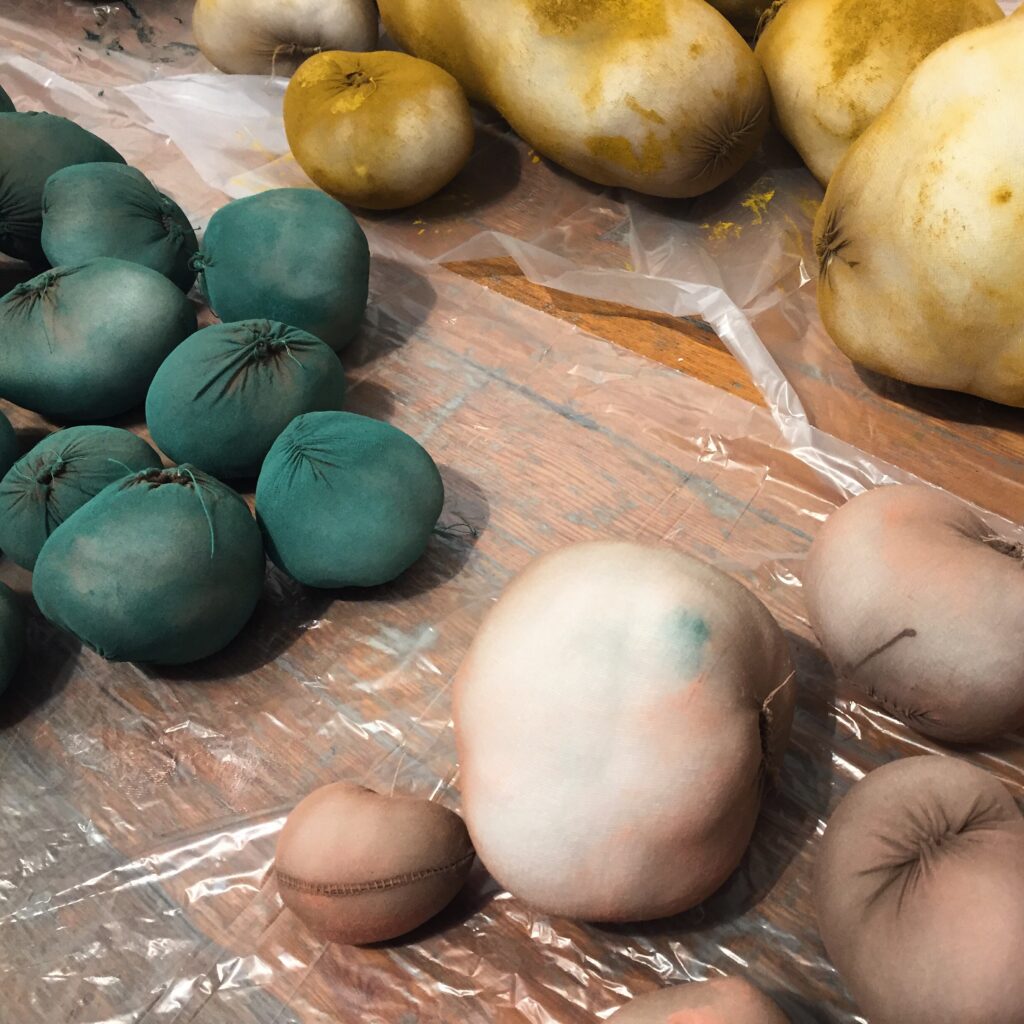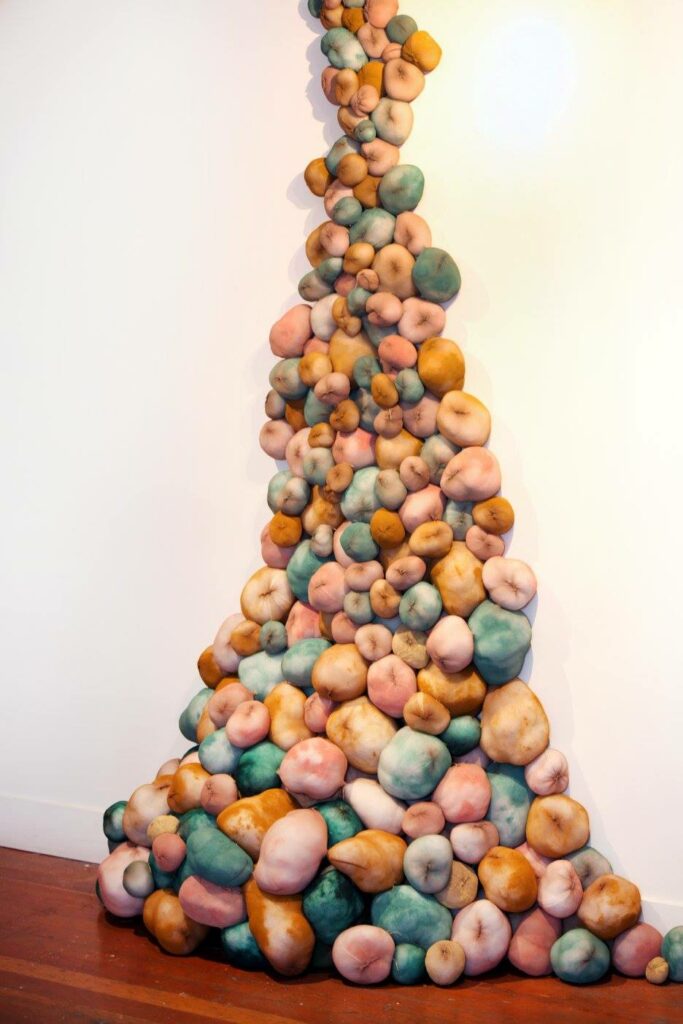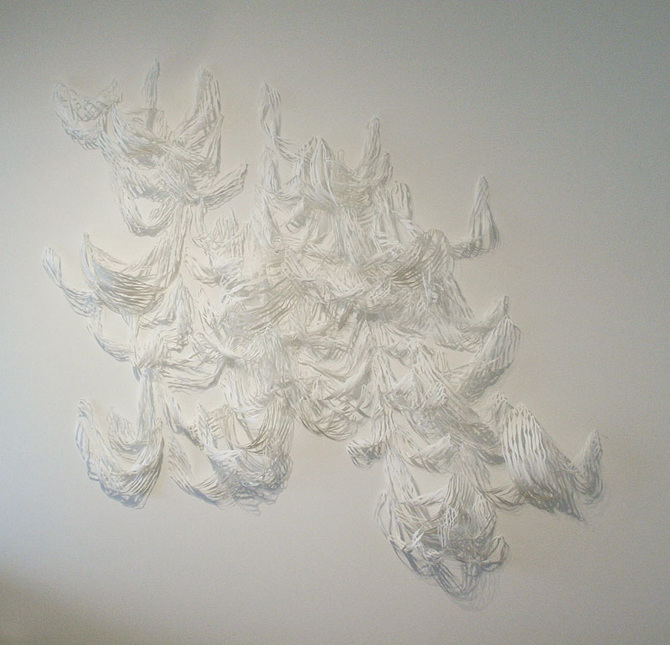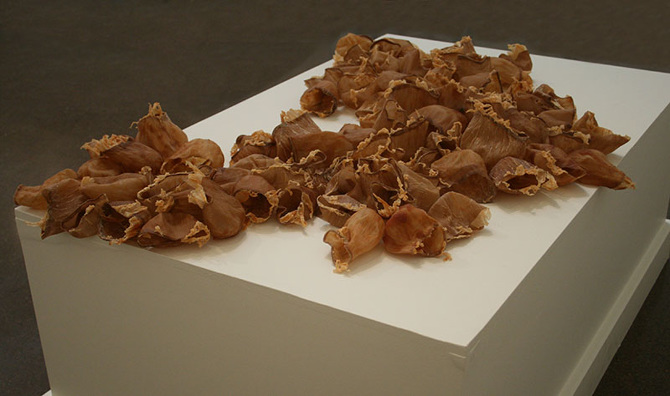
December seems to be the month of all things wacky, whimsical, and weird here at Root Division. From our annual Misfit Toy Factory event on December 10 to Eliza Dennis’s latest work in the Frank-Ratchye Project Space–this month is about one-of-a-kind work that is both intriguing and bizarre. If you missed the live artmaking at the Misfit Toy Factory Creative Marketplace last Saturday, mark your calendars for next year and check out the available works for sale in our online store (through Dec. 21st).
You can still get a glimpse of Eliza Dennis’s Objects fall like this, living things fall like this, which is on view through December 21. I recently had the pleasure of chatting with Eliza about this latest work.

Lauren Etchells: Eliza–your installation in the Frank-Ratchye space looks fantastic. It was so fitting for the Misfit Toy Factory event last Saturday! Can you speak a little bit more about this new work and the process behind it?
Eliza Dennis: Much of my work explores the human qualities of ordinary objects. Right now, I’m working with lingerie and other intimate materials to underscore the psychological effects associated with the loss of ownership over one’s body, whether through injury, politics, sexualization or disassociation. I wanted to use pantyhose because of its long history as a feminist art material and because of its obvious connection to the body. The materials for this piece have a sexual connotation and an obvious intimate usage. It is impossible to be a woman at this point in time and feel optimistic about how your body is viewed or treated. The irrelevance of the sexual misconduct claims towards Donald Trump in October and the election of a vice-president who is staunchly pro-life has left me with so much discomfort as a female. I individually cut and sewed all the sacks closed and then sewed them together around a small motor to make it shake. The iterative nature of my work is very important to me because the obvious labor behind my piece adds to the sense of growth and expansion I’m trying to convey.
LE: Where do you look for sources of inspiration?
ED: I start all my pieces by doing tests and experiments with combinations of materials. It’s really the physical properties of the materials I work with that inspire my work. I am constantly testing how these materials interact with gravity and if I can change their natural states by adding another material or by creating a new texture or pattern through sewing, cutting, or painting them. Contemporary dance also acts as a major inspiration for me, especially when exploring the capabilities of the human body and its structure. It helps me to understand how one object/person can be buoyant and then heavy in quick succession.
LE: Your sculptures often look very organic. How do you go about designing the shape and structure of your pieces?

ED: My process is very intuitive. I’m particularly interested in the connections objects have with each other, and I hope to highlight these moments when objects fall away or squeeze up against each other. These places of tension are so emotive. Because my work is contingent on materiality, I let my objects act according to their natural state, outside of their ordinary function, and only manipulate them in order to hang them on the wall or attach them to each other.
LE: What drew you to working in such a large-scale format?
ED: In my work I hope to create empathy between the viewer and my objects. When a viewer is immersed in an environment we tend to feel a stronger emotional impact. When objects are at scale with the human body, you are more likely to anthropomorphize them and this is exactly what I strive to do. It’s all about noticing your body in space and in relation to this foreign object.
LE: What kinds of textures are you drawn to?
ED: I am particularly drawn to textures that are skin-like or reminiscent of organisms, human or other. It’s why I tend to work with cloth, pantyhose, paper, latex and wax. These natural materials have human qualities that remind the viewer of their own body and physical make up.

LE: The textures in your work definitely seem to elicit a reaction from viewers. How do you want the viewer to feel when looking at your work?
ED: I want the viewer to understand the psychological effects of anxiety. I don’t intend to force anyone into feeling a certain way, but I hope the discomfort of my pieces will elicit some reaction. I think “negative” feelings and emotions are necessary to understanding other people. The easiest way to empathize with others is to understand their darker feelings because in a lot of ways these are more powerful and long-lasting emotions.
LE: Is there an element of fear–fear of the grotesque, deterioration, etc.–present in your work?
ED: Absolutely! Fear is present in my work because of its close connection to anxiety. A lot of my work deals with bodily deterioration. At the age of 18, I got hit by a truck while riding my bike and I had this intense feeling of being betrayed by my body as I went through the healing process. We all feel like we must know how our bodies function, but when it comes to injury and pain, there is so much that we still don’t understand. It took a lot of time for me to trust my body again, to trust that it heals and mends—that organic systems don’t only decay with age, but can grow and strengthen. I believe my work vibrates in this space between growth and decay, optimism and pessimism, as well as beautiful and grotesque.
LE: Are there any other artists you’re looking at?

ED: I’m constantly looking at other artists’ work, but some old favorites are Chiharu Shiota, Nari Ward and Eva Hesse. I’m a huge fan of Chiharu Shiota because her installations are so immersive and emotive and she works at a scale I hope to pursue one day. Nari Ward for his ability to exploit the original use of materials to add conceptual clarity and layered meaning to his pieces. Finally, Eva Hesse for her incredible vision while working at the intersection of minimalism and materiality.
LE: What is it like having a studio here at Root Division?
ED: It’s incredible! I’m still pinching myself that I get to surround myself with such socially-conscious artists. We are such a diverse group of artists right now and I am consistently inspired and challenged by the variety of methods and concepts with which my peers are working. Root Division has provided me the opportunity to expand my practice and create larger installations. I could not have asked for a better support system as an emerging artist.
LE: We are so excited to have you here as well! And congratulations on this new work.
Make sure to check out Eliza’s solo exhibition in the Frank-Ratchye Project Space before it closes on December 21.
